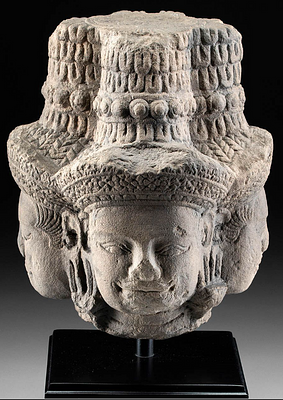Greek Attic Red-Figure Stemmed Kylix w/ Nike
Lot 29a
About Seller
Artemis Gallery
686 S Taylor Ave, Ste 106
Louisville, CO 80027
United States
Selling antiquities, ancient and ethnographic art online since 1993, Artemis Gallery specializes in Classical Antiquities (Egyptian, Greek, Roman, Near Eastern), Asian, Pre-Columbian, African / Tribal / Oceanographic art. Our extensive inventory includes pottery, stone, metal, wood, glass and textil...Read more
Categories
Estimate:
$7,000 - $10,500
Absentee vs Live bid
Two ways to bid:
- Leave a max absentee bid and the platform will bid on your behalf up to your maximum bid during the live auction.
- Bid live during the auction and your bids will be submitted real-time to the auctioneer.
Bid Increments
| Price | Bid Increment |
|---|---|
| $0 | $25 |
| $300 | $50 |
| $1,000 | $100 |
| $2,000 | $250 |
| $5,000 | $500 |
| $10,000 | $1,000 |
| $20,000 | $2,500 |
| $50,000 | $5,000 |
| $100,000 | $10,000 |
| $200,000 | $20,000 |
About Auction
By Artemis Gallery
Jun 29, 2023
Set Reminder
2023-06-29 10:00:00
2023-06-29 10:00:00
America/New_York
Bidsquare
Bidsquare : Exceptional Antiquities, Ethnographic and Fine Art
https://www.bidsquare.com/auctions/artemis-gallery/exceptional-antiquities-ethnographic-and-fine-art-13031
Artemis Gallery info@artemisgallery.com
Artemis Gallery info@artemisgallery.com
- Lot Description
Ancient Greece, Athens / Attic, ca. 6th century BCE. A gorgeous pottery kylix boasting red-figure decoration of a winged Nike (Roman Victoria), the Greek goddess of victory, speed, and strength, holding a wreath before an altar. The divine beauty stands facing right, her hair tied up in a neat bun and crowned by a headband as a long, pleated peplos cascades down her slender body. A ring of stopped meander motif surrounds the goddess. The vessel itself presents a graceful form with a wide, shallow bowl flanked by a pair of horizontal handles, all supported by a pedestal foot. A lustrous black glaze envelops the majority of the vessel, save the interior of the handles, the central red-figure decoration, and the underside of the foot. Just imagine the surprise when one finished their wine only to reveal the beautiful imagery of this winged goddess! Size: 8.3" L x 11.3" W x 3.3" H (21.1 cm x 28.7 cm x 8.4 cm)
Perhaps the most exciting innovation in Greek vase painting was the red-figure technique, invented in Athens around 525 BCE and beloved by other artists of Magna Graecia. The red-figure technique allowed for much greater flexibility as opposed to the black-figure technique, for now the artist could use a soft, pliable brush rather than a rigid metal graver to delineate interior details, play with the thickness of the lines, as well as build up or dilute glazes to create chromatic effects. The painter would create figures by outlining them in the natural red of the vase, and then enrich these figural forms with black lines to suggest volume, at times perspectival depth, and movement, bringing those silhouettes and their environs to life. Beyond this, fugitive pigments made it possible for the artist to create additional layers of interest and detail as we see in this example.
Virtually no ancient Greek paintings have survived the tests of time. This makes the painted compositions found on ceramic vessels like this example invaluable sources of information about ancient Greek visual art. Refined dishes like this kylix were not merely utilitarian pottery, but rather works of art in their own right, highly prized throughout the classical world.
Provenance: private Orange County, California, USA collection acquired before 2000
All items legal to buy/sell under U.S. Statute covering cultural patrimony Code 2600, CHAPTER 14, and are guaranteed to be as described or your money back.
A Certificate of Authenticity will accompany all winning bids.
We ship worldwide and handle all shipping in-house for your convenience.
#178914Professionally repaired with restoration and repainting in areas. Some light surface wear and loss of white pigment, all commensurate with age. Otherwise, very nice presentation with silvery iridescence and good remaining detail. Christie's tag attached to handle. Old Christie's tag attached to handle.Condition
- Shipping Info
-
All shipping is handled in-house for your convenience. Your invoice from Artemis Gallery will include shipping calculation instructions. If in doubt, please inquire BEFORE bidding for estimated shipping costs for individual items.
-
- Buyer's Premium



 EUR
EUR CAD
CAD AUD
AUD GBP
GBP MXN
MXN HKD
HKD CNY
CNY MYR
MYR SEK
SEK SGD
SGD CHF
CHF THB
THB

















